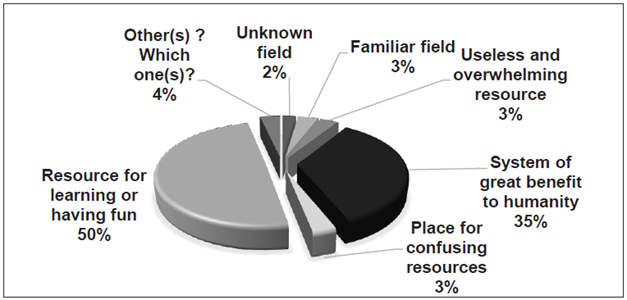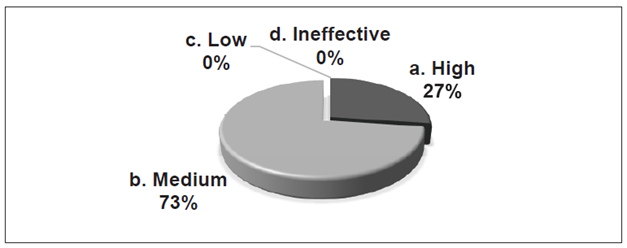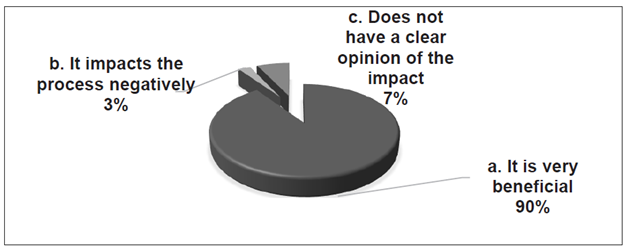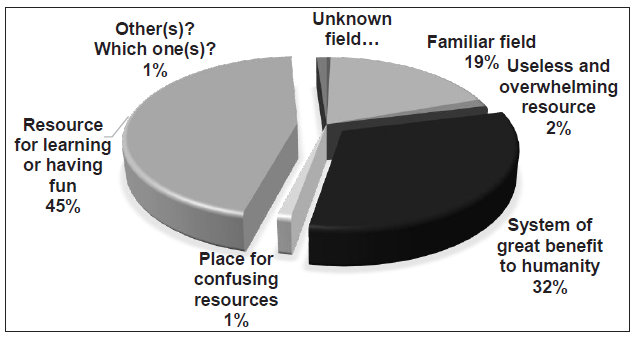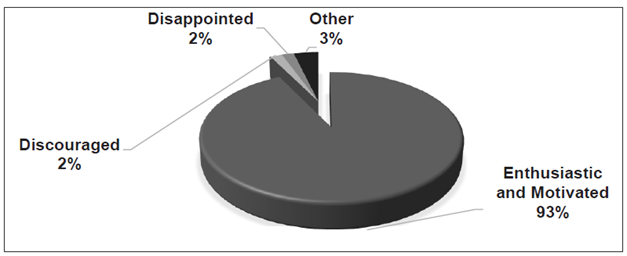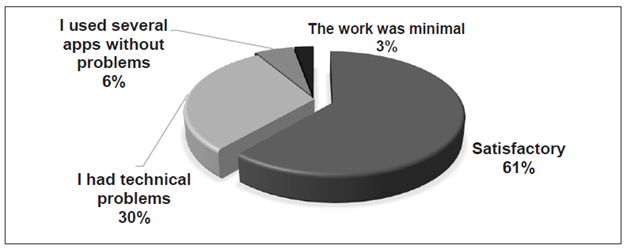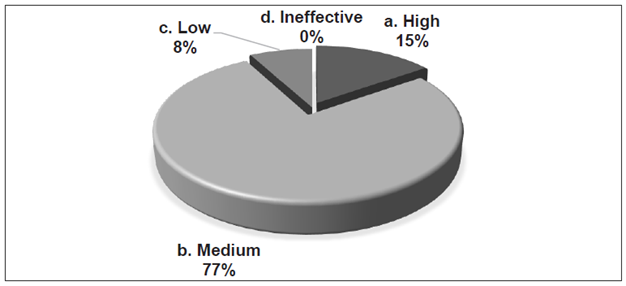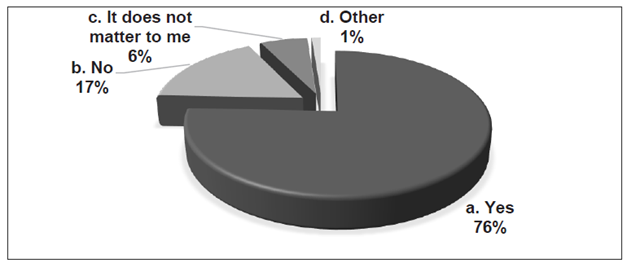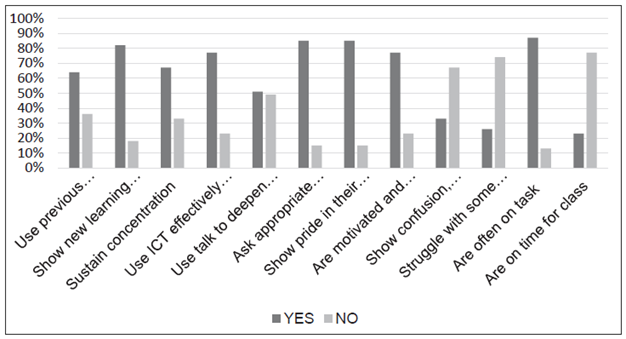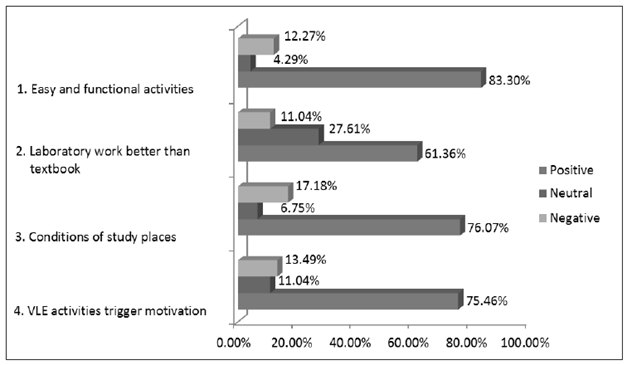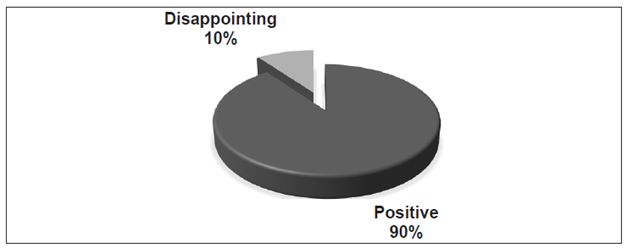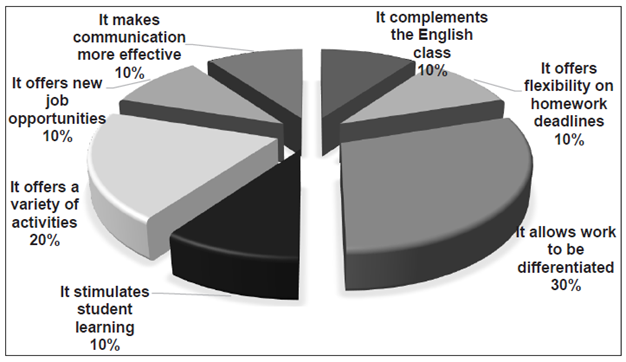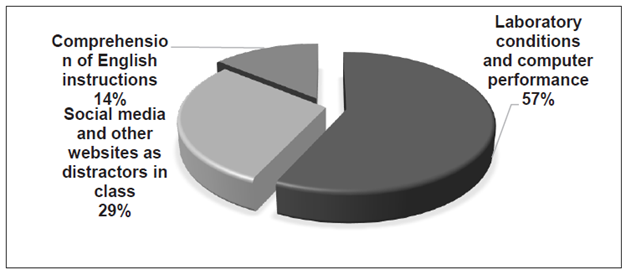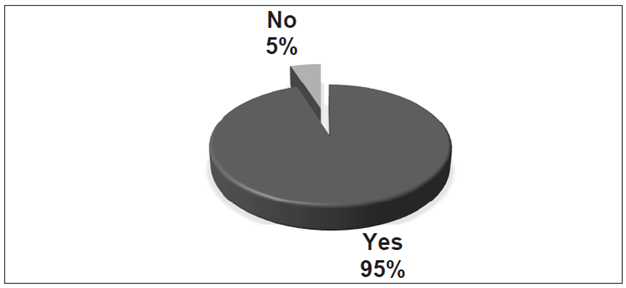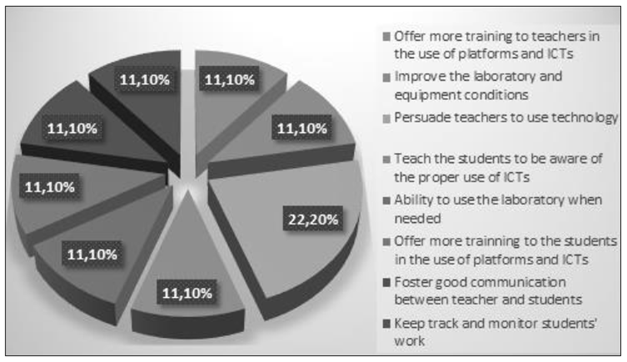Introduction
With the growth and spread of information and communications technology (ICT), a massive interest has developed in how computers, other devices and Internet tools can benefit and improve educational processes and foster the use of technology in language classrooms (Rahmany, Sadeghi & Chegini, 2014). One resource offered by ICT is online learning platforms (OLPs), also known as learning management systems (LMSs), course management systems (CMSs) or virtual learning environments (VLEs), as they have been referred to in this study. These different denominations may bear significant or subtle differences in terms of their purposes or functions, but it is not within the scope of this article to examine such distinctions.
VLEs are virtual spaces that teachers and students can use to present and share resources and activities and interact with one another. These platforms can be used to teach a complete online course or as a supporting feature for face-to-face courses. VLEs provide a means to manage the learning experience, communicate the intended learning experience and facilitate tutors' and learners' involvement in the experience (Sneha & Nagaraja, 2013). Their main goal is to ease, motivate and provide learning experiences that go beyond the classroom. Authors such as Barker & Gossman (2013) claim that VLEs boast a wide spectrum of research showing positive impacts across different contexts (p. 22).
The VLEs available to students for this project were Edmodo, Schoology and Uscovirtual. The first two have gained a reputation worldwide as open-access online learning environments, whereas the latter is a closed-access VLE used at the public institution targeted in the study. These three platforms have proved to be secure learning environments over the researchers' teaching experiences. Most teachers from the teacher education program and those surveyed for this study have used these platforms at different times over the years and state that their experience in terms of pedagogical benefit, technological advantages and practicality has been positive. No teacher has ever reported any harm caused by the use of the aforementioned VLEs.
Yet, despite the many benefits a VLE can bring to teachers and students, there are voices that do not favor the implementation of these platforms in the educational process. Some regard VLEs as a waste of time, others as a resource that does not offer added value to the teaching-learning process, while others go beyond to state that this type of technology does little to stimulate students' learning. In this regard, Godwin-Jones (2012) states, "VLEs are unlikely to be very attractive or stimulating to students because they are far removed from the vibrant, ever changing online world in which our students are fully engaged" (p. 6). Walker & White (2013) go even further to claim that the nature of the VLEs, being more institution-led rather than teacher-led, "might be one of the reasons why many teachers do not get fully engaged with all the facilities that they offer" (p. 143).
Thus, in order to confirm the impact -whether positive, negative or harmless- of implementing a VLE in an EFL classroom within the context of a Colombian public university, the following specific objectives have been established: to analyze students' perceptions regarding the use of a VLE in their language learning process; to identify the advantages and disadvantages of using a VLE from both the student and the teachers' perspective; analyze students' attitudes while working on the VLE; to identify and describe extraneous factors that may foster or hinder the implementation of a VLE; and finally, to determine the feasibility of implementing a VLE in an EFL course.
Literature review
The theoretical constructs that support this study are based on authors such as Dudeney & Hockly (2007), Green, Brown & Robinson (2008), Walker & White (2013), and Ayres (2002), in regards to the conceptualization of VLEs and their role in education, the approaches of computer-assisted language learning (CALL), technology-enhanced language learning (TELL) and mobile-assisted language learning (MALL), and the review of different research studies within these fields.
Technology in educational settings: Learning in the digital age
Learning through technology has become the core focus for researchers in language learning since the 1970s, when the CALL approach took on a meaningful role. The main concern has been whether technology can bring positive or negative results to students' learning processes, and whether computer-mediated learning may facilitate foreign language learning. It is only natural that the inclusion of computers has drastically impacted conventional classroom teaching, where teachers were traditionally regarded as the main conduit of knowledge. As students and teachers have become more proficient in the use of new technologies, more and diverse opportunities have emerged for educators in terms of curriculum design and teaching strategies, and for students in terms of learning possibilities and strategies. In advocating the modern approach of technological multimodality, Walker & White (2013) claim:
Both teachers and language learners need to be capable of interpreting and producing texts which contain both visuals and words. We argued that this involved teaching a new kind of "literacy," and that the teacher's role might specially be that of promoting critical analysis of such texts. (p. 92)
According to Molnar (1997), Donald Bitzer first introduced computers in the field of education in 1959 through a project called Programmed Logic for Automatic Teaching Operations (PLATO). It was a large-scale project created at the University of Illinois and implemented at a few schools and colleges across the United States. Molnar describes the historical transition of computers in education as being originally used for basic operations in several disciplines and extended later to research processes. Molnar (1997) states that in 1963 John Kemeny and Thomas Kurtz granted computers a more academic function by developing a versatile computer language, BASIC, which enabled the creation of computer-based instructional materials to be used in educational settings.
Yet it was not until the late seventies that the expensive time-shared system was switched to the lower-cost option of microcomputers, resulting in the birth of the personal computer. This allowed a significant growth in the use of computers in homes and offices, which in turn increased people's computer technology literacy.
Today, there is a closer connection to information and knowledge resulting from instantaneous access to immense amounts of omnipresent data. However, these machines are useless if they are not accompanied by a meaningful application to improve education, specifically in the realm of helping students learn better, faster and more efficiently. Those desires have led us to a new perspective on learning through the Internet, which has evolved from other major approaches in language teaching and learning.
"The advent of hand-held computer-based devices gave rise to mobile-assisted language learning (MALL) as we know it today" (Burston, 2013, p. 157). According to the author, MALL has focused on the use of technologies such as pocket electronic dictionaries, personal digital assistants (PDAs) and MP3 players, among others. New forms of communication based on online synchronous and asynchronous communication (Facebook, Email, Skype, WhatsApp, Line, etc.) through smartphones have made a considerable impact on how humans interact and communicate (Ngwenya, Annand & Wang, 2004; Chen, Liu & Wong, 2007; Murphy, 2009). For some people these breakthroughs are seen as an unconventional menace, putting at risk the traditional social communication and interaction paradigm during this new digital age in education (Siemens, 2004; Selber, 2004; Rose & Meyer, 2002).
Nevertheless, these changes have been inevitable over the last few decades because of the advent of new technologies and their penetration into all aspects of life. That is why such a shift has enhanced the adaptability specifically of teachers who are consistently thinking of how to help students succeed in their learning process. These teachers have come to understand that the "youth of today communicate with friends through cellular phones, email, instant messaging, blogs and chat rooms. Projects that involve communication through the web, in the form of a website, tap this interest in communication" (Green, Brown, & Robinson, 2008, p. 13). Teachers should take advantage of both the technology expertise and excitement that students bring with them in order to learn from them and connect the use of technology to their teaching (Walker & White, 2013).
Needless to say, computers and other technological devices today are pivotal instruments through which learners can access knowledge anytime and anywhere. As Solomon & Schrum (2010) suggest, "Web 2.0 applications are replacing -and improving on- student access to information, communications, and collaborations; and some districts are moving to virtual schooling" (p. 167). VLEs, then, constitute one of the recommended paths towards such purposes.
Virtual learning environments (VLEs)
A VLE is an online system comprising a range of tools to support and manage learning (JISC, 2010). Green, Brown, & Robinson (2008) refer to course management and learning management systems (CMS/LMS) as "software packages that allow an instructor to deliver portions of or an entire course via a Web-based environment" (p. 17). As these authors suggest, VLEs play the role of supporting instruction by allowing teachers to select and use different resources and applications to review course content. CMS and LMS have been used interchangeably to describe a virtual meeting place for teachers and students. Dudeney & Hockly (2007) portray them as "web-based platforms on which course contents can be stored" (p. 137). A "VLE allows you to create online courses and to enroll students in them; inside the courses themselves you can combine various resources with more interactive elements, like quizzes, questionnaires..." (Dudeney & Hockly, p. 153). For example, teachers can use chat to communicate with their students directly or send a message, and if they want to interact with their learners, they can use Skype or videoconferencing to arrange a meeting. These applications are examples of how external tools can be linked to a VLE as a repository.
VLEs can be one of two types. On the one hand, a VLE can consist of software sold by a company to an educational institution, with the teacher following the uploaded activities and resources. On the other hand, a VLE can be set up by the teacher within free software. In other words, as Walker & White (2013) put it, the former is more institution-led, while the latter is teacher-led. For teachers who may find the use of a VLE time-consuming because they have to adapt VLE activities to course content and provide personalized feedback to students, the institution-led VLE type might be a preferred option; whereas for those who like to create their own tasks and play with technological applications, the teacher-led VLE might be the choice. "This of course, involves teachers in more work and may require some technological expertise, as opposed to institutional VLEs which do it all for you" (Walker & White, 2013, p. 143).
Yet, while some teachers find VLEs fascinating and meaningful, others regard them as challenging and even uncomfortable. Some teachers may fear exhibiting a perceived technological weakness when using the VLE platform in front of students who might be more digitally savvy. As Walker & White (2013) put it, "At present, of course, because of age differences, most university lecturers, like most school teachers, are 'digital immigrants' and most students are 'digital natives'" (p. 142). This categorization has been widely described in the fields of CALL and technology-enhanced language learning (TELL), which also clearly depict the conflicts that cross the paths of educational initiatives intending to promote a technology-based teaching approach.
Some VLEs are currently developing their functionality on mobile devices, which can consolidate their role in language learning. This is how MALL has also become an important venue for teachers and practitioners to promote greater exposure to another language. Over the past decades, mobile devices have been mainly used for digital dictionaries, language learning websites and audio and video players (mp3 and mp4), among other functions. However, the availability of a VLE platform on these devices can render even greater benefits for both language teachers and learners.
Mobile devices are equipped with sophisticated applications that may make learning a foreign language easier and more effective. At the very least, their portability allows students to be more fully in contact with the language they are learning even in circumstances that were not possible with personal computers. Thus, teachers and students are finding a complementary path to learning in MALL. As Stockwell & Hubbard (2013) stated, "Mobile language learning is a field that is quickly maturing, and to this end, a growing body of research has appeared that highlights the various ways in which mobile devices may be used in the teaching and learning of languages" (p. 2).
MALL, as part of the broader field of CALL or TELL, has contributed to forging paths to language learning in ways that perhaps do not replace the work of teachers in the classroom, but complement it in significant manners. The constant use of mobile devices by our youth and students, and even by us, constitutes a reality that teachers and researchers must acknowledge in order to find its feasibility within the educational setting. Some research studies on the use of computers and mobile phones can shed light on their practicality and effectiveness.
Studies on students' opinions and attitudes towards the use of educational technology
Modern technologies have been smoothly implemented in the field of language teaching and learning to the extent that both teachers and students now have an array of tools for, modes of, and paths to a more effective language teaching and learning process. As Ayres (2002) suggests:
The combination of text, audio and video make multimedia an excellent format for language learning materials and have led to the birth of an industry in computer-assisted learning (CAL). The availability of digital video materials for the computer has added a further dimension to the use of computer-assisted language learning (CALL) and is an increasingly important part of the language learning process. (p. 256)
This combination of different paths to learning has brought the attention of researchers and teachers to the multiliteracy perspective, which is intended to complement rather than replace the work of teachers in the classroom with the advent of new technologies. In this regard, Boche (2014) states that "multiliteracies recognizes [sic] both the increasing cultural and linguistic diversity in the new globalized society and the new variety of text forms from multiple communicative technologies" (p. 116).
Despite the benefits that the use of technology can bring to the language teaching and learning field, there are also opinions and reactions that may not support such benefits. It is easy to think that students may receive the use of technology enthusiastically as they are already accustomed to dealing with digital gadgets in their daily routines. As Dudeney & Hockly (2007) state, "Younger learners are growing up with technology, and it is a natural and integrated part of their lives" (p. 7). The authors go on to support the existence of the digital divide between digital natives (those who grew up using technology) and digital immigrants (those who have come late to the world of technology), a topic repeatedly discussed today. Another divide is drawn between technophobes and technophiles, that is, those who are afraid of using technology and those who are eager to use it. Another divide worth mentioning includes the impossibility for some learners to access modern technologies, whether for economic or cultural reasons. In spite of belonging to a high-tech era, some students and teachers do not have equal opportunities to access the different technological devices available to so many youth today. The aforementioned lines have been drawn to describe the gap commonly found between teachers' and students' digital competences.
Yet feelings of reluctance and fear from learners towards educational technologies have also been evident through different studies. In a study on learners' attitudes towards the use of CALL, when students were asked about their preferred mode of learning English, a significant percentage of respondents favored classroom-based teaching versus computer-based (Ayres, 2002, pp. 246-247). In Simsek's study (2008), participants expressed their preference for pencil and paper exams versus online exams. They argued that online exams caused them greater anxiety, were more difficult and did not provide much feedback. Likewise, in Ushida's study (2005), students showed a high level of anxiety during their courses through Carnegie Mellon University's Language Online (LOL) project, due perhaps to "the lack of familiarity with the specific LOL learning environment" (p. 66). The fact that students were accustomed to a different type of learning and communication impacted their motivation, at least in the first part of the research process. The author goes on to claim:
Courses like LOL may make regular study difficult for students who cannot wisely direct their own learning processes. To put it another way, the LOL courses can offer flexibility in terms of pace of learning and how to learn; yet, at the same time, not all students can take advantage of such a learning environment and may find it difficult to manage their own learning. (p. 69)
As previously stated, there are both positive and negative manifestations in regard to the use of technology in language learning. For the implementation of MALL, for example, Stockwell & Hubbard (2013) claim,
Research has for the most part shed a very positive light on the potential of the role that mobile devices may play. At the same time, however, there has also been indication of several areas that certainly deserve consideration in their implementation (p. 2).
The outcomes of the present study will either confirm or complement some of the aforementioned manifestations.
Methodology
Research design
Even though this research project uses elements of quantitative research methods, it mainly constitutes a descriptive qualitative study. Instruments that have been prominently used in qualitative studies, such as observation and interviewing are accompanied in this study by numerical data such as raw numbers and percentages. Most procedures and characteristics of the present study are found in Creswell's (2009) definition of qualitative studies:
Qualitative research is a means for exploring and understanding the meaning individuals or groups ascribe to a social or human problem. The process of research involves emerging questions and procedures, data typically collected in the participant's setting, data analysis inductively building from particulars to general themes, and the researcher making interpretations of the meaning of the data. (p. 22)
Hence, a text that describes the perceptions of the use of the VLE and ICTs as well as their attitudes when interacting with technology will result. Descriptive statistics and qualitative research instruments will be used to give meaning to the questions or hypotheses herein stated.
Instrumentation
Entry questionnaires
Both teachers and students completed a structured survey that inquired about their digital competence level, opinions regarding the use of ICT in school, and experience with VLEs and different technological applications. A ten-question computer survey was administered to the five teachers at the beginning of the process. Likewise, a thirteen-question paper survey was administered to students. Time constraint was the only reason to not transfer participants' surveys to a computer version. Surveys were structured with multiple-choice questions, which meant respondents took no longer than ten minutes to complete them.
Class observation forms
These forms contained four sections that organized what the research assistants observed and described: classroom resources, the teacher, the students, and the use of the VLE. Two assistants were assigned to each group so that we could have different perspectives of the observed processes and elements, thus providing greater validity to the results. In order to enhance validity and reliability, Fraenkel, Wallen & Hyun (2012) suggest the procedure of "checking one informant's descriptions of something (a way of doing things or a reason for doing something) against another informant's descriptions of the same thing" (p. 458).
The seven groups were visited every other week resulting in a total of about 45 observation visits and 90 completed observation forms.
Quick surveys
This five-question survey followed a Likert-type scale structure and was administered randomly to five participants at the end of every English class they visited. The survey asked participants about their opinions regarding the VLE-based activities, the technological applications, the computer lab conditions, and the whole lesson. This instrument intended to check participants' responses against researchers' observations. A total of about 175 quick surveys were administered during the first semester of the academic year.
Exit questionnaires
Unlike entry surveys, exit surveys were administered via computer on the last week of the term. These surveys maintained a significant resemblance to the entry surveys in terms of the questions since some key factors were intended to be re-assessed. Additional questions were added, though, for a total of 17 questions. The information contained in these surveys will complement, confirm or contradict the information deposited in the observation forms.
Teachers' narratives
These instruments correspond to the exit inquiry tool for teachers. The narratives contained four prompts that asked teachers about their experiences with the VLE, the benefits of the process, their opinions regarding participants' response in class, the contribution of ICT to language learning, and recommendations for future implementation. Informants were encouraged to elaborate on their answers and were given enough time to complete them.
Participants
About 210 students from seven different institutional English courses (IECs) participated in this study as well as the five instructors for those courses. Two teachers taught two different courses. These IECs correspond to English courses offered as a graduation requirement for students from different undergraduate programs at a public Colombian university. This sample of convenience was chosen based on characteristics the teachers of these courses had. First, an invitation with a general description of the study was sent to about 40 teachers. Ten teachers accepted the invitation to participate, but after further discussion on the details and expectations of the project, only five were ultimately selected. The main requirement to participate was to demonstrate, through an interview and the review of formal instruction credentials, a high level of ICT competence and experience with the use of a VLE.
Regarding the distribution of the participating students' sexes, 53.7 % of them were female and 46.3 % male. In regard to ages, 56.7 % were between 21 and 25, 37.8 % were between 15 and 20, 3 % were between 26 and 30, 1.2 % were between 31 and 35, and 1.2 % were older than 35.
Ethical considerations
Students gave their consent to participate in the study and were informed of all the details of the process. It was clear to both the teachers and the students that no personal information would be revealed nor any kind of harm caused to any of the participants. The teachers were also told that the study was not intended to focus on assessing their teaching performance and methodologies, but rather on how students reacted to the use of technology and the conditions surrounding the implementation of a VLE in their English courses. Despite the fact that some research assistants were present in class carrying out observations, their presence did not seem to cause any distraction to the teachers nor intimidation of students.
Data analysis
The data contained in the entrance questionnaires for teachers and students, observation forms, quick surveys, exit questionnaires, and the narratives were revised to correct inconsistencies. Then, we proceeded to follow the model proposed by Creswell (2009) which consists of "organizing and preparing the data for analysis, reading through all the data, coding the data, interrelating and interpreting themes and descriptions, and interpretation of the meanings of themes" (p. 185).
Methodological triangulation was used to analyze the data. This triangulation made it possible to contrast the information contained in each of the instruments and thus reveal possible findings in light of the issues analyzed through the research question and specific objectives.
Some data are presented through raw scores and percentages, bar graphs, pie charts, and descriptions. Thus, the data are synthesized by means of themes that were somehow deductively extracted from both the research question and the specific objectives.
Results
The most significant responses according to the nature of the study were selected to be depicted.
Students' entrance questionnaire
Figure 1 shows the results of the students' entrance questionnaire, which was administered at the beginning of the research process. This instrument was aimed at identifying the perceptions students brought with them regarding technology and its use in their language learning process. Three questions were selected from this instrument.
For most of the students (88 %), the Internet was a beneficial resource for either learning or having fun. Few students (8 %) still saw the Internet as an unknown, confusing, useless and overwhelming resource.
As it may be expected, students rated their digital or computer competence as medium or high, medium being the one with the highest percentage (see Figure 2).
Most students (90 %) regard the use of technology in their learning process as beneficial (Figure 3). Few students (7 %) have a neutral opinion, while even fewer (3 %) think the use of technology impacts the learning process negatively.
Students' exit questionnaire
Since this instrument was administered once the research process was completed, more questions were selected to describe the impact of the implementation of a VLE on students' opinions and attitudes in an EFL class.
Compared to the results of the entrance questionnaire, the percentage of students holding a positive opinion of the Internet (Figure 4) increased to 96 %. Only 2 % of participants still regarded it as a useless, overwhelming or confusing resource.
Very few students (4 %) expressed feelings of demotivation and disappointment (Figure 5). Most students expressed a feeling of satisfaction (93 %), with class observation notes written by a research assistant to support it: "Students become enthusiastic when working with the platform."
Figure 6 shows that despite the fact that a large percentage (61 %) of students had a satisfactory experience with the VLE, a significant minority (30 %) of students showed some dissatisfaction owing to technical problems when using the VLE, such as slow connectivity, insufficient resources, no connection to some websites, and the like. The following comment supports this latter claim: "Connection to the Internet is slow, which causes a waste of time in the development of class activities."
The number of students who regarded their competence with the VLE as high decreased when compared to the entrance questionnaire. Figure 7 shows that 8 % of students expressed a new response category: "low competence."
A significant number of students suggested including a VLE in their classes (Figure 8). Nonetheless, there was still a good percentage of the sample which were either undecided regarding the use of a VLE or suggested not incorporating it in class.
Class observation forms
The description in this section will focus on the observed students' attitudes while working with the VLE.
Students showed a wide range of behaviors during the VLE-based lessons. These behaviors were explicit through both actions and comments, as shown in Figure 9. The categories that describe the students' attitudes when using the VLE were previously established in the class observation form used for the present study. The different descriptors were framed within three main categories: the teacher, the students and the technological conditions (VLE included).
In regard to the students' attitudes, it was observed that they often used their previous experience as the basis for new learning. They also showed new skills and understanding. They seemed to use the different ICT from the VLE effectively and creatively. 26 % of the students struggled with some digital applications. Even though students did not use the L2 much to deepen understanding, the questions the students asked were regarded as meaningful. For the most part, students stayed on task and sustained concentration. They showed pride and engagement throughout the process as well. However, some negative reactions during this process were also evident in terms of enthusiasm, concentration, technological competence, and articulation between previous and new learning. A clear negative aspect that is represented in the above graph is the arrival time to class. It can be argued that since the VLE lessons always took place in the computer lab, students may have seen this as a more fun and informal class, resulting in higher rates of tardiness.
Quick survey
Figure 10 shows the results of a quick opinion survey that was carried out. It contains the answers of 163 surveys completed after five laboratory sessions. Participants answered five specific questions related to their experience after having worked with the VLE in their English class.
For 83.3 % of the participants, "The VLE and digital applications used in the development of classroom activities were easy and functional." 61.36 % of the participants preferred to work with technological resources rather than the textbook. Yet it is interesting to note that 27.16 % seem to feel fine working with either the text or a technological resource such as a VLE. 76.07 % of the participants state that "the laboratory or the conditions where the class activities took place were adequate." Finally, for 75.46 % of the survey participants, the "VLE activities trigger learners' motivation."
Despite the concerns voiced by some students and witnessed by the research assistants regarding technical problems that occurred with the lab resources and Internet connectivity, there was a significant consensus in terms of favorable learning conditions. Although the number of computers in the lab was not enough for the size of the groups, the Internet did not always connect or it was sometimes very slow, a significant number of participants expressed a positive opinion of the lab conditions, quality of the activities and impact of the VLE on motivation.
Teachers' narratives
The following is the description of the answers provided by the teachers in the narratives. Six questions within three main categories were asked. The answers to these questions were intended to correlate and support students' answers from the other instruments. Only the data that we regard as most relevant to support the conclusions and recommendations, along with their pie charts, are presented.
Teachers expressed that the use of the online platform was beneficial, enriching and practical for students (see Figure 11). On the other hand, there was one teacher who graded this experience as disappointing because of the way she was directing the online platform, which she called "too behaviorist."
The teachers' responses highlighted the benefit of differentiated work, which is an advantage that online platforms offer to students. This type of process allows participants to work at their own pace. The benefit of having a variety of activities and a different type of learning environment was also stated. As seen in the graph, the remaining responses highlighted aspects like communication, flexibility with assignment deadlines, learning stimulation, and how the VLE positively complements the class (see Figure 12).
The highest percentage of results pertaining to obstacles met in the process (Figure 13) is related to the conditions of the laboratory, which includes Internet speed, headphone and computer performance, and technical problems with the air conditioner. Additionally, the teachers noticed that the students were easily distracted by social networks or other fun sites. The ability to understand instructions in English was also mentioned as a limitation for learners when performing activities.
A very high percentage of answers concerning students' attitudes was positive, with 95 % answering affirmatively when asked if students had a positive reaction to the use of a VLE in class (see Figure 14). The teachers stated that using a VLE was motivating and helped the pupils improve their performance.
As previously stated, recommendations to improve the class using VLE correlate to or support students' opinions and attitudes towards the VLE implementation (Figure 15). They also provide meaningful insights into the advantages and disadvantages of the process. The main suggestion has to do with persuading teachers to use technology (22.2 %) being all the other aspects recommended in similar proportion (11.1 %).
Conclusions
When it comes to students' perceptions of the use of a VLE in their language learning process, it can be concluded that the number of students who regarded the use of the Internet and the resources that come with it as useless, confusing and overwhelming decreased significantly after gaining experience with it. These students see the use of a VLE as beneficial and find the applications used during the process easy and functional. As it may be expected, the majority of students prefer using ICT resources over the traditional textbook; however, there is still a portion of the student population that, despite the emergence of modern technologies, is not convinced of this choice. The exposure to educational technology, not the same technology they use in their daily lives, somehow encouraged students to believe that their digital competence was not as high as they stated at the beginning of the study. Likewise, their teacher's technological competence was not as low as the students originally perceived. Those students who have been known as digital natives may be skillful at using the gadgets and applications they frequently use for communication or entertainment, but they struggle with the tools and programs that serve more academic purposes. Nonetheless, students suggest that teachers should indeed include technology in class.
As advantages, it was found that the use of a VLE allows for differentiated instruction, that is, the possibility for "teachers to proactively modify curricula, teaching methods, resources, learning activities, and student products to address the diverse needs of individual students and small groups of students to maximize the learning opportunity for each student in a classroom" (Bearne, 1996; Tomlinson, 1999, p. 121). Having a plethora of activities and resources in the VLE is like having the opportunity to access learning through multimodal channels 24/7. Likewise, assignment deadlines can be flexibly set beyond class time constraints, which may be of great benefit to some types of learners. In short, the VLE per se is not a panacea but may offer a learning environment that can more perfectly complement traditional classroom work.
With regard to the disadvantages, it was found that the technological capacity of some educational institutions continues to be a threat to the implementation of a VLE in EFL courses, and the distraction caused by social networks and other entertainment sites may pose impediments to the process as well. It is the teacher's responsibility to cope with these threats in a resourceful and meaningful manner.
Regarding learners' attitudes, most students felt motivated and enthusiastic about using a VLE in their EFL courses. The use of a VLE somehow encouraged students to perform their tasks better while allowing them to gain confidence to develop their linguistic skills. Students showed improvement in class participation and behavior; they were for the most part on task throughout the process and tended to connect background with new knowledge. They showed interest in the technological resources and activities due perhaps to the interactivity and availability of learning tasks, meaning they had permanent access to them and got immediate feedback on their performance.
According to students' opinions, these activities promote the development of autonomous learning as well as effective teacher-student communication. Despite the technical difficulties they mentioned, their experience with the VLE was for the most part satisfactory, and students were eager to share new knowledge with others. Additionally, while we know students in general are constantly surfing the Internet, and it was found by the end of the study that the time dedicated to this purpose at home increased even more, the conclusion is that this was perhaps due to the VLE tasks assigned by the teachers. Furthermore, some students still struggle with educational applications that may require abilities other than those they frequently use with personal electronic gadgets. But notwithstanding the aforementioned disadvantages, in the end, the use of a VLE provided students with a less stressful learning environment. This conclusion correlates to other studies, which claim that the Internet provides students with a less threatening means to communicate, resulting in increased engagement, confidence, responsibility (Skinner & Austin, 1999), and resourcefulness to cope with tasks in the VLE.
Extraneous factors that may hinder or foster the implementation of a VLE in an EFL course are the use of digital gadgets in class, teachers' ICT competence, the infusion of technology in schools, the condition of labs, and the Internet connection speed. For instance, some teachers still see the use of mobile phones in class as a threat, whereas others may use them as a valuable resource for students' L2 learning process; likewise, the level of technological competence that teachers exhibit may influence the types of technologies they incorporate into their teaching and their investment time in class. Also, the quality of the Internet or conditions of the labs may encourage or discourage both teachers and students from using a VLE and all technologies associated with them.
In conclusion, despite the threats and limitations previously described, it can be stated that the implementation of a VLE in the EFL courses was not only feasible and functional throughout this study, but also highly recommended in many educational processes such as the one targeted here, the L2 learning process.
Limitations of the study
As stated, for some teachers the implementation of VLE activities presented them with certain challenges due to the fact that the number of students per course surpassed the number of computers in the lab. Sometimes two or even three students had to work together on one computer. Also, the Internet connection sometimes caused frustration in both the teacher and the students, resulting in some activities that required audio or video streaming being cancelled. These threats to the smooth implementation of Internet-based activities do not allow learners to enjoy the multiple benefits of ICT, thus impacting their perceptions on the use of educational technology.
Recommendations
Regardless of the low interest some teachers may still have for the use of modern technologies, these are inevitable parts of our students' lives, and therefore their implementation in today's classrooms is fast becoming fundamental. As Prensky (2001) claims, "Children and young people are 'digital natives' who think differently from adults and need more visual content, games, and rapid changes of pace than previous generations." (p. 170). As the teachers proposed in their narratives, school administrators need to continue advocating for the infusion of new educational technologies and training for their faculty, students and staff in general.
In terms of the teaching and learning experiences, the use of mobile phones, social networks and applications such as online translators and dictionaries should be regarded by teachers as great benefits that technology brings to the L2 teaching and learning process. They should serve as meaningful supports and complements to both teachers' instruction and students' learning. It is recommended that teachers coach learners on the potentialities and best uses of online dictionaries and other applications with pedagogical purposes. This will help teachers cope with the anticipated fear of student distraction during the use of new technologies. It is perhaps a gradual process that may render invaluable benefits to L2 learners.
The inclusion of technology in the English courses was positive and rewarding for teachers and students alike. However, the use of VLEs for learning communities was underexploited. None of the results gathered demonstrated that VLEs were used to promote social interactions with external peers and networks, even though Edmodo and Schoology are instruments that foster collaboration with L2 learning communities worldwide. Thus, a VLE should be used beyond the function of content repository to that of making global connections.
A fundamental recommendation for the application of technology in the language teaching process is to avoid total dependency on this resource for any given lesson. In other words, when teachers prepare their courses, they should consider that "wherever you use technology you should always have a back-up plan in place. There might be times when the websites are down, the computers crash, or worse, the electricity goes off. So be prepared" (Duderstadt, Atkins, & Van Howelling, 2002, p. 42). This is necessary to avoid all the constraints that technology poses to teaching and learning. Indeed, it is very important to keep an ace up our sleeve in case the class in the virtual environment cannot be successfully developed; feelings of frustration whenever technology breaks down must be coped with using back-up plans in teaching and a positive attitude towards this unavoidable reality.
Lastly, we can continue talking about the beauty of modern technologies, but ultimately, their benefits rely partially on the investment university administrators make in their infusion into curricula. In the case of the present study, the need for further investments is quite evident. The implementation and upgrading of technological facilities and resources will undoubtedly benefit the academic community. Likewise, the school administration and IT officers are expected to complement the technology infusion with permanent training programs that allow for better exploitation of the resources.
English teachers in particular are called upon to keep up with advancements in educational technology, including VLEs and ICT in order to promote learning paths that better fit the needs and interests of our digital-age students. Similarly, it is recommended that researchers continue to delve into this field in order to shed light on the great potential for harmonious and fruitful blending of technology and language learning.













